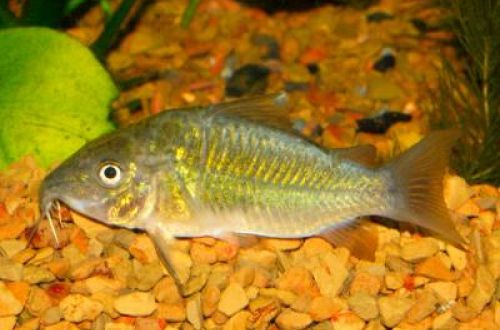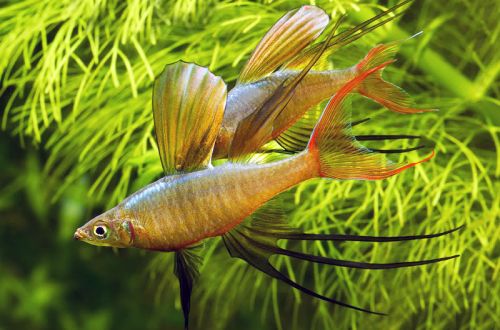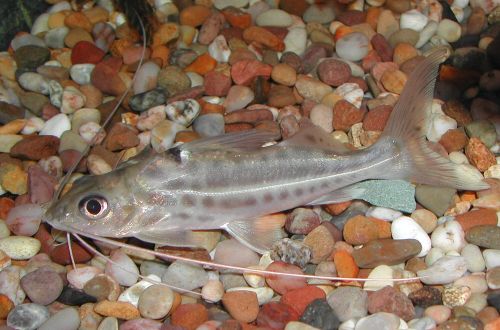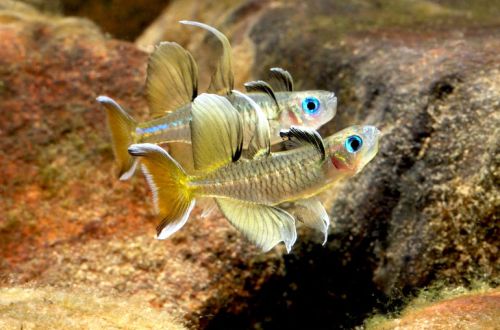
Emerald catfish
Emerald catfish or Brochis green (Corydoras splendens) got its name from the body color, shimmering from metallic blue to emerald green, depending on the light.

The catfish is suitable for most general aquariums, has a peaceful disposition and lives mainly in the lower layers of the water, interrupting the ground in search of food. due to its lifestyle and diet it is an excellent aquarium cleaner.
Under the name “Emerald Catfish”, three types of catfish are supplied to retail chains, which are practically indistinguishable from each other. All three representatives of South America have the same requirements for their maintenance and feeding.
Emerald catfish are known for their skill in keeping the substrate clean by eating leftover food and plants, however this should not be their only source of food, the substrate should also be periodically siphoned.
Habitat
The emerald catfish (Corydoras splendens) was first described by explorer François Castelnaud in 1855. They live in the upper part of the Amazon River (Brazil, Peru and Ecuador), inhabits rivers, tributaries and reservoirs with stagnant water. These fish live in shallow water with silty soil and dense vegetation. Catfish stay in a flock, prefer shallows with oxygen-enriched water, but if necessary, they can rise to the surface for a breath of air. In their natural habitat, the main food source for them is worms, insects, small crustaceans and plants.
Description
The fish is of medium size, an adult reaches 8–9 cm. The color of the fish depends on the lighting, the scales can cast green, blue-green or dark blue. The anal and pelvic fins are light yellow to match the abdomen (in females it is closer to pink), the caudal and dorsal fins are darker brown.
Food
The fish is not whimsical in food, with pleasure it absorbs all types of live food and dry industrial food, in order to maintain the right balance, it is recommended to combine different types. Since Brochis green lives in the lower layers of water, dry food should be sinking (flakes or granules), in addition to live food, frozen food can be used.
Feeding 1-2 times a day
Maintenance and care
Catfish is quite simple to maintain, the only important condition is an enhanced filtration and aeration system. If the fish often floats to the surface for a breath of air, then there is a low level of oxygen in the water due to poor aeration or a clogged filter. Unlike their other catfish cousins, the Emerald catfish requires more light, so it’s worth limiting the number of floating plants so as not to unnecessarily shade the aquarium.
Catfish live in groups; when kept alone, they become timid and shy. To create favorable conditions in the aquarium, shelters should be made from twisted roots or pieces of wood; caves or grottoes can be built from stones. Brochis green constantly sorts out the soil with its sensitive antennae so that they do not get injured; fine gravel should be used as a substrate.
Water: change part of the water every two weeks
The emerald catfish will fit perfectly into any community – they are sociable, not aggressive, lead a flock of life, so there should be a group of at least 6 fish in the aquarium. Single content is not recommended.
Breeding / breeding
Determination of sex by external signs is extremely difficult, but when kept in a group, the likelihood of having at least one female and male increases dramatically, so you won’t have to choose partners separately.
It is problematic for a novice aquarist to breed these catfish, since it is difficult to reproduce all the necessary conditions in a home aquarium. Catfish breed during the rainy season, so to start spawning, it is necessary to lower the water temperature by a couple of degrees. The female lays from 900 to 1100 eggs, attaching them to stones, plants and other objects. Eggs are prone to fungal infections, so antifungal drugs should be used during maturation of the masonry.
Diseases
The emerald catfish is hardy and does not get sick in favorable living conditions. Particular attention should be paid to the antennae with which he sorts through the soil, in the case of a high concentration of ammonia, they may become infected.





